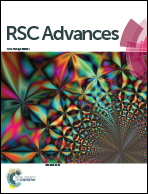Preparation and characterization of PEG-g-MWCNTs/PSf nano-hybrid membranes with hydrophilicity and antifouling properties
Abstract
In this study, polysulfone (PSf) nano-hybrid membranes have been successfully fabricated by loading modified multi-walled carbon nanotubes (MWCNTs) as the dispersed phase using the phase inversion method. MWCNTs were chemically functionalized with polyethylene glycol (PEG) to achieve better dispersion in the polymer matrix. PEG-g-CNTs were confirmed by ATR-FTIR and XPS spectroscopy. The hybrid membranes showed better hydrophilicity, higher pure water flux and more excellent antifouling properties. The results demonstrated that the membrane containing 1.5 wt% PEG-g-MWCNTs showed the lowest contact angle (53.9°) and the highest water flux (71.26 L m−2 h−1) which was significantly higher than that of the pure PSf membrane and MWCNTs/PSf membrane. In BSA filtration analysis, the modified MWCNTs led to significant improvement of the fouling recovery ratio (FRR) and dramatic reduction of the adsorption amount of BSA. In addition, membranes exhibited excellent tensile strength after the addition of PEG-g-MWCNTs.


 Please wait while we load your content...
Please wait while we load your content...